This traditional ossobuco recipe is rich, full of flavour and super easy to make at home. Serve on any occasion for the perfect Italian meal.
Ossobuco alla milanese is made by braising tender veal shanks in a rich broth, and is traditionally served with saffron risotto (or risotto milanese), and gremolata, a refreshing green sauce.
This popular recipe from northern Italy is incredibly easy to make at home, and it's sure to wow your guests at the dinner table on any special occasion.
If you’re looking for a fancy but easy holiday dinner recipe for Christmas, Thanksgiving, or New Year’s Eve, you can't go wrong by making traditional ossobuco.
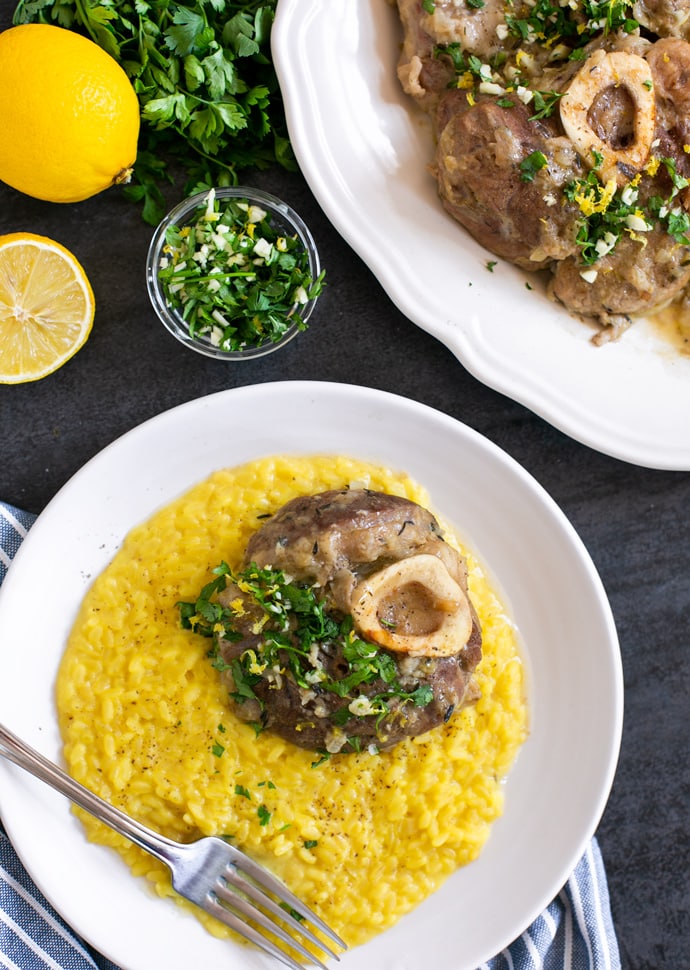
Jump to:
What is ossobuco?
The term "ossobuco" comes from Italian, of course. "Osso" means "bone" and "buco" means "hole" so it translates to a bone with a hole.
The name refers to the main ingredient, veal shanks with the bone marrow attached.
The "Ossobuco alla milanese” means Milan-style ossobuco, and it’s the most popular Italian veal shank recipe.
The veal shanks are cut into thick slices, and briefly sautéed in olive oil or butter. Then they’re braised in wine, broth, and herbs.
When you braise meat you cook it slowly in a covered pan with a small amount of liquid.
Braising only happens when the food is partially submerged in the cooking liquid, the moment you cover the meat in liquid, you’re stewing.
Ossobuco should be braised and not stewed, this allows the meat to absorb all the seasoning and at the same time add richness to the sauce.
The classic ossobuco Milanese is topped with gremolata, a zesty Italian herb sauce, and served with the equally famous risotto alla Milanese ( saffron risotto).
There are plenty of other sides that go well with it, and you can find a few ideas at the end of the post.
Ossobuco ingredients
You don't need any fancy ingredient to make classic Italian ossobuco.
All you need is less than 10 simple ingredients:
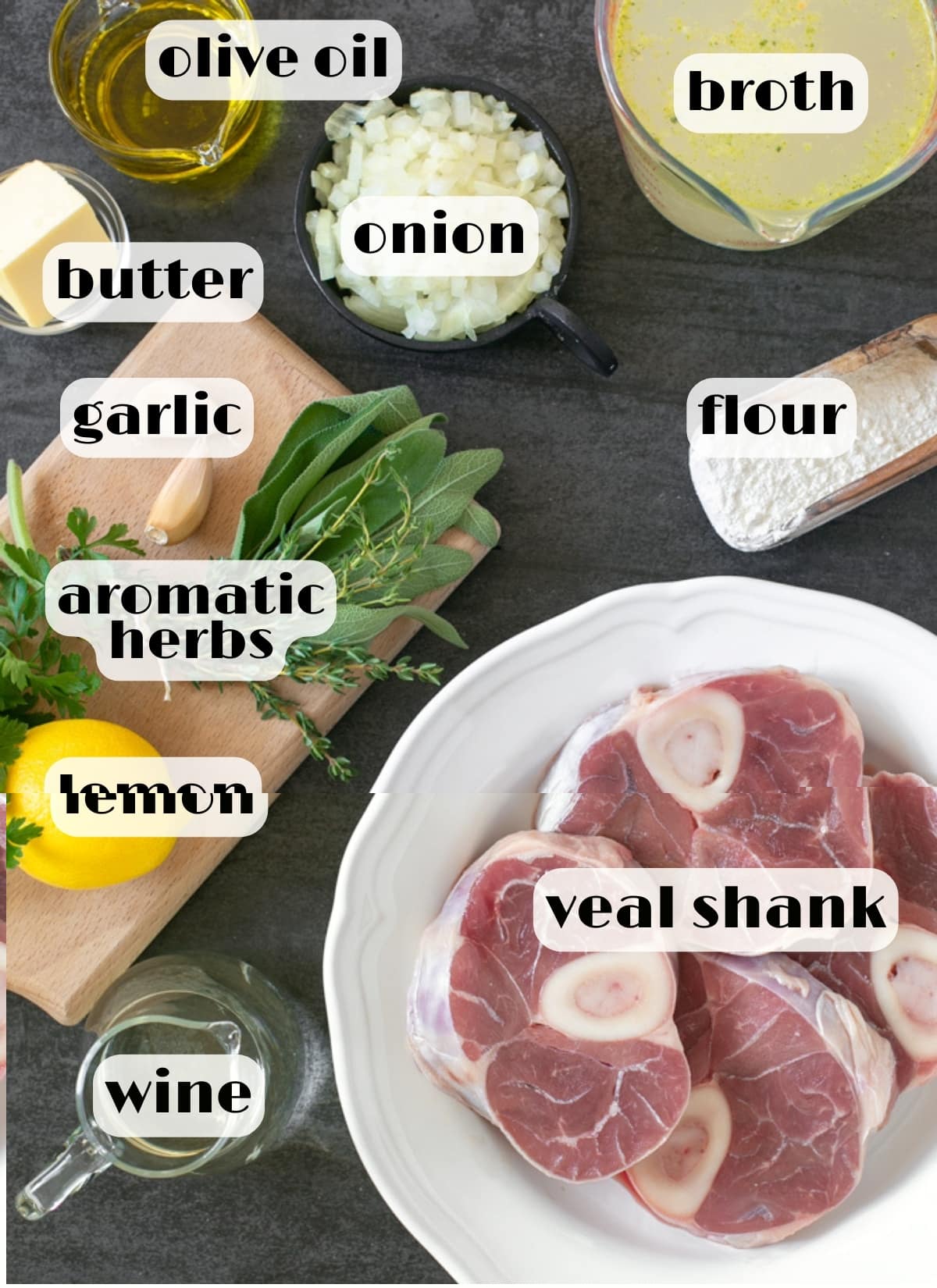
- Veal shanks: They should be approx. 1 ½” thick (3 cm) each. You can use beef shanks, but veal shanks are more tender.
- Onion: Yellow or white onion works well for this recipe.
- Extra-virgin olive oil: You can easily substitute it with butter for a richer flavor.
- White wine: Use good quality dry white wine if possible.
- Broth: Opt for vegetable broth for a delicate note, and chicken broth or beef broth for a stronger flavor.
- Fresh aromatic herbs: I use a mix of sage and thyme. Rosemary works well too.
- Gremolata: Use fresh garlic for a more delicate aroma, flat parsley, and lemon zest, I recommend using organic lemons.
WHAT IS GREMOLATA?
The gremolata is an Italian green sauce made with a mixture of finely minced fresh flat-leaf parsley, lemon zest, and garlic.
The best way to use gremolata is as a topping on ossobuco. The combination of lemon and herbs gives the braised meat a fresh and aromatic note.
Gremolata also goes very well with other meat or fish dishes. It’s great on grilled chicken or fish.
VARIATIONS
This recipe has been around since at least the eighteenth century and, like all recipes, it is subject to different variations.
Although the traditional recipe doesn’t call for tomatoes (just like the classic Bolognese sauce), recent versions see a little tomato in the mix.
You can add 1 teaspoon of tomato paste or 1 tablespoon of passata (pureed tomatoes).
Another version calls for extra veggies.
You can add 1 finely chopped carrot and 1 finely chopped celery stalk together with the onion (basically making a soffritto for your ossobuco).
How to cook ossobuco Milanese
Preparing ossobuco is actually relatively easy.
It takes about 10 minutes of active cooking, then the meat slowly cooks until perfection, without much babysitting.
Here's a
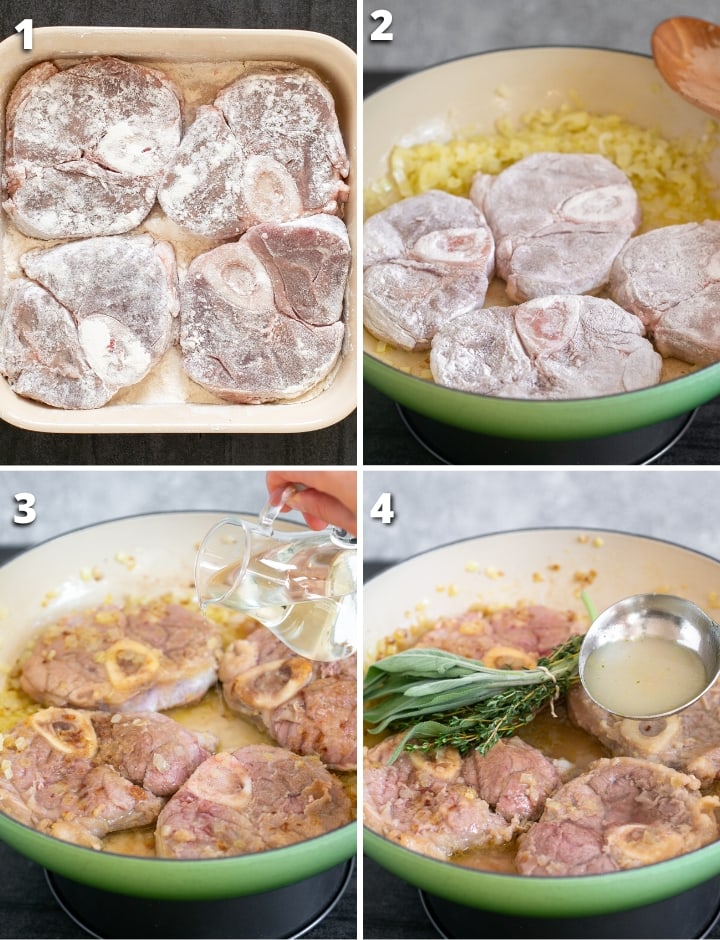
STEP 2. Lightly flour the meat slices on both sides, shaking the flour in excess.
STEP 3. Cook the onion in a large pan, then add the veal shanks and brown them on both sides.
STEP 5. Pour in the white wine, and let it evaporate, then add in the aromatic herbs.
STEP 6. Pour in enough stock so that the meat is just half-submerged in the liquid. Lower the heat, cover, and cook for about 1½ hours, adding a bit of broth when necessary, to keep the meat moist.
As soon as the meat can easily fall from the bone, the ossobuco is ready.
In the meantime, prepare the gremolata and pour over the veal shanks when serving.
Did you know? In Milan, ossobuco usually comes with a small spoon on the side called “esattore”, for easily extracting the bone marrow.
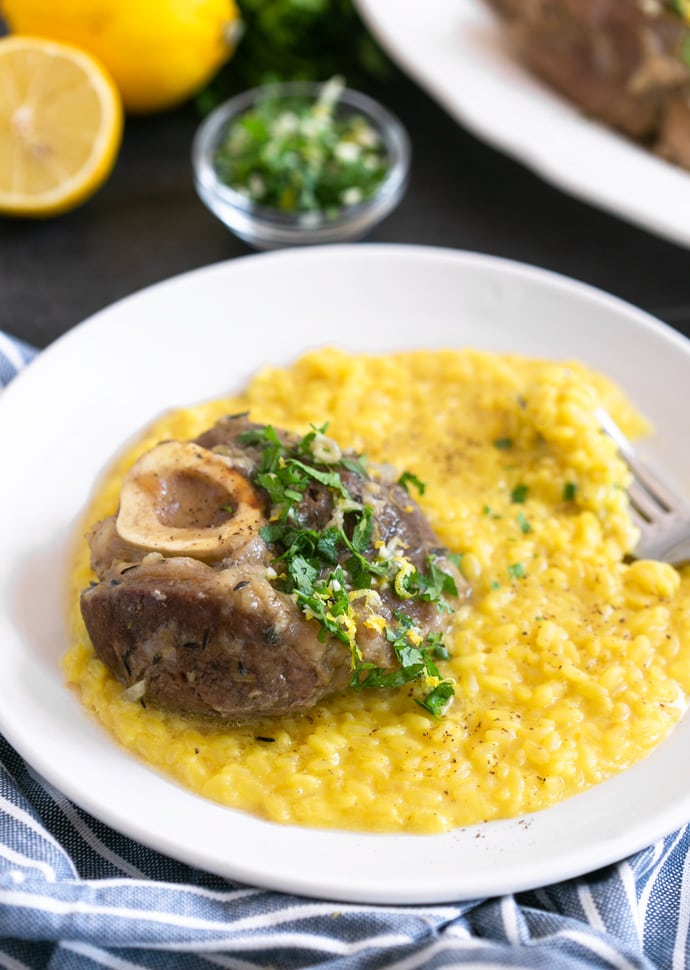
COOK IT IN THE OVEN
Alternatively, you can cook the ossobuco in the oven.
Use an oven-friendly cast iron pot to first brown the meat, then add the broth, wine, and herbs, then transfer the pot to the hot oven.
Cook at 180C (360F) for about an hour, turning the meat halfway through cooking time.
What to serve with ossobuco
In Milan, ossobuco is served with risotto alla Milanese, and it's simply the perfect pairing!
If you’re not in the mood for risotto, here are a few fantastic alternatives:
- Polenta: A creamy polenta (corn grits) is also ideal. With its smooth consistency and mild taste, it's a great side for braised veal.
- Potatoes: Roasted potatoes or mashed potatoes are a fantastic side.
- Rice: Less laborious than risotto, cooked rice is also a good side dish. I like to add a bit of butter and Parmesan to give it a risotto feeling without all the fuss.
- Bread: Grilled sourdough bread or ciabatta is the most simple side dish. And it allows you to make “scarpetta”, basically you dip the bread in the brothy sauce and wipe the remaining sauce off the plate.
Recipe FAQs
Yes, you can prep and cook ssobucco the day before.
After cooking it, store it in the fridge, then the next day, bring it to room temperature before very gently re-heating.
To serve: reheat, covered, in preheated oven to 150 C /300 F, for about 30 minutes, adding a little extra broth (or water) to prevent the meat from drying out.
Yes, you can! Transfer the cooked meat and its juices to an airtight container, and store in the freezer for up to 1 month.
Thaw the meat overnight in the refrigerator, which maintains a food-safe temperature, then reheat as suggested above.
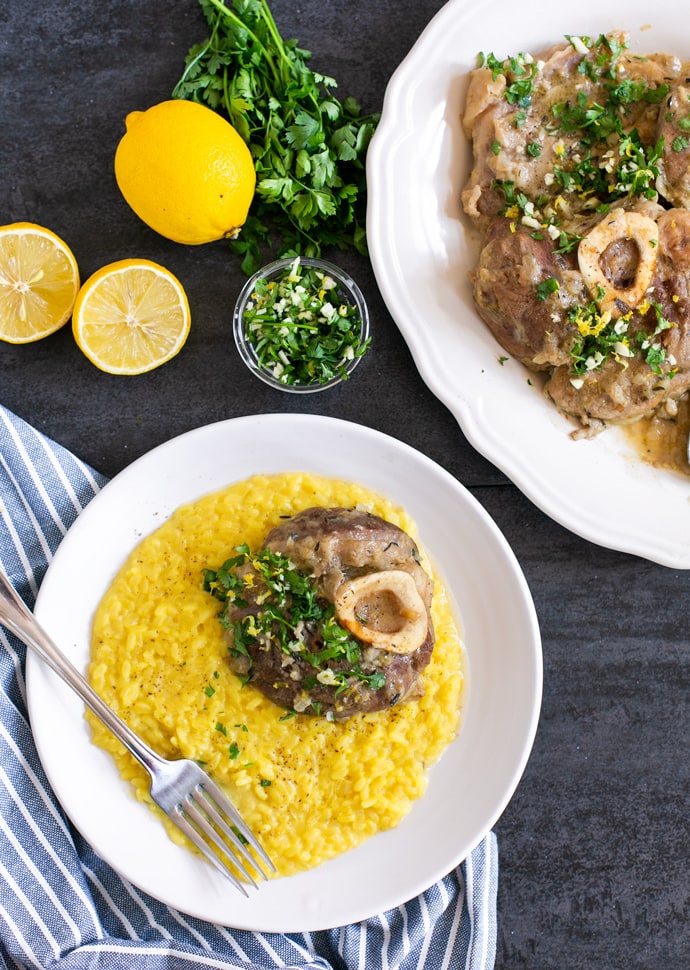
More traditional Italian dinner recipes to try
- Traditional Italian Pasta e Fagioli
- Veal Saltimbocca
- Panelle - Chickpea Fritters
- Pasta alla Norcina
- Parmigiana di Melanzane - Eggplant Parmigiana
- Classic Italian Pizza Dough
- Italian Tomato Sauce
- Traditional Bolognese Sauce - Beef Ragu'
Did You Try This Recipe?
Please let me know how you liked it! Leave a comment below and share a picture on Instagram with the hashtag #thepetitecook!
Don't forget to subscribe to my newsletter and follow along on Facebook, Pinterest and Instagram for all of the latest updates.
Recipe
Ossobuco alla Milanese
Ingredients
- 4 veal shanks, 1 ½ inches thick, 9-12 oz each
- 3 tablespoon all purpose flour
- 3 tablespoon extra-virgin olive oil, or butter
- ½ white onion, finely chopped
- ½ cup white wine, (120 ml)
- 2 cups vegetable or beef broth, (480 ml)
- sea salt and freshly-cracked black pepper
- 1 garlic clove
- zest of 1 organic lemon
- handful fresh flat-leaf parsley
To Serve:
Instructions
- Make small incisions over the outer lining of the veal shunks. This will prevent the slices from curling during the cooking time.
- Place the flour in a large bowl or shallow dish, and lightly flour the meat slices on both sides, shaking off the flour in excess.
- Heat the extra-virgin olive oil in a large pot over medium-low heat, add the onion and cook until translucent, stirring often to prevent it from burning.
- Add in the veal shanks and brown them on both sides.
- Turn the heat to medium, pour in the white wine, and let it evaporate, about 3-5 minutes.
- Pour in enough stock so that the meat is just half-submerged in the liquid. Season with sea salt and black pepper to taste. Lower the heat to a minimum, cover, and cook for about 1½ hours, adding a bit of broth when necessary, to keep the meat moist.
- Right before you take the meat off the heat, prepare the gremolata. Finely chop together the garlic with the lemon zest and parsley, and mix all the ingredients together.
- Remove the pot from the heat, top each slice of veal with the prepared gremolata, and serve with risotto alla milanese or your favorite side dish.
Notes
Nutrition
The information shown is an estimate provided by an online nutrition calculator. It should not be considered a substitute for a professional nutritionist’s advice.





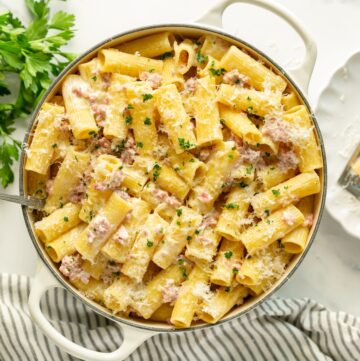


Rachel says
Oh my goodness this looks simply incredible! A must for Sunday lunch today I think!